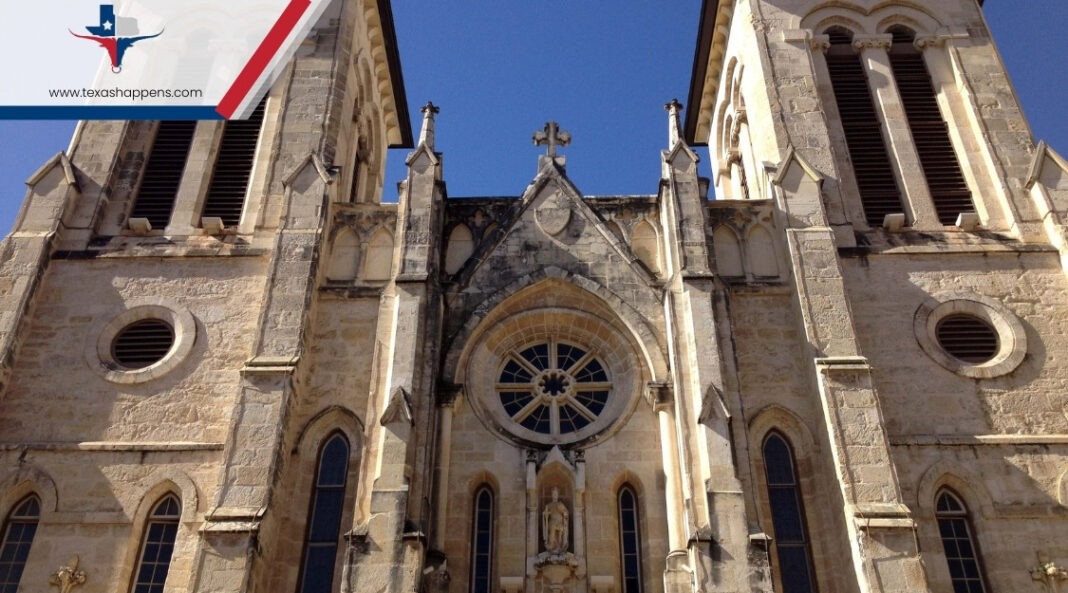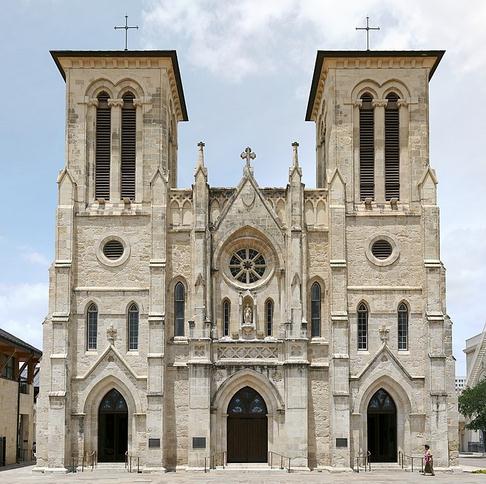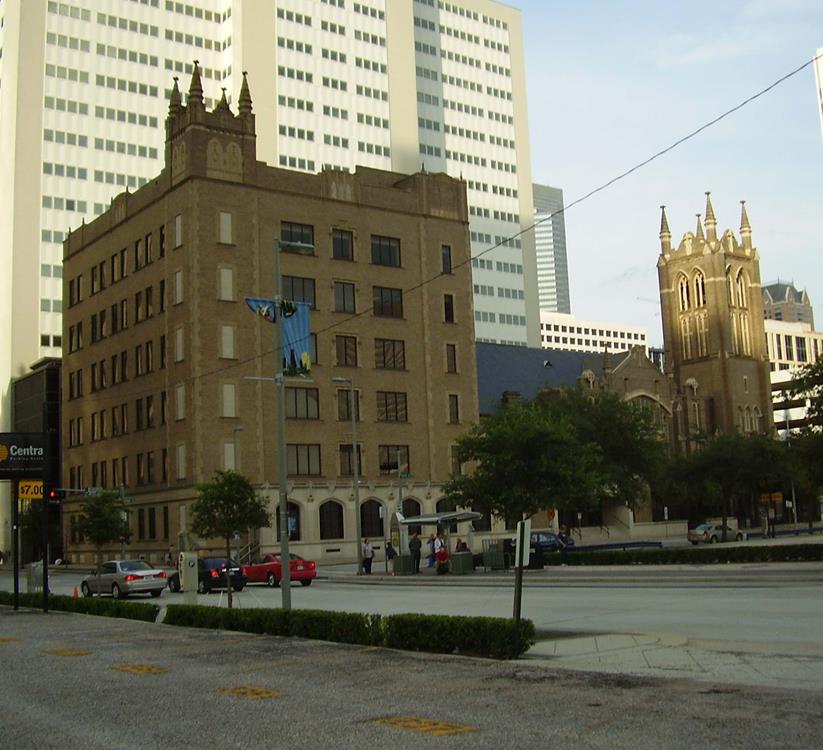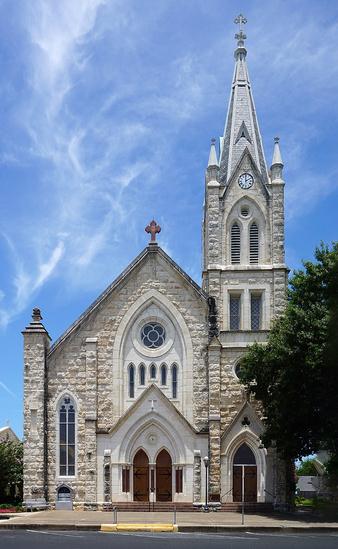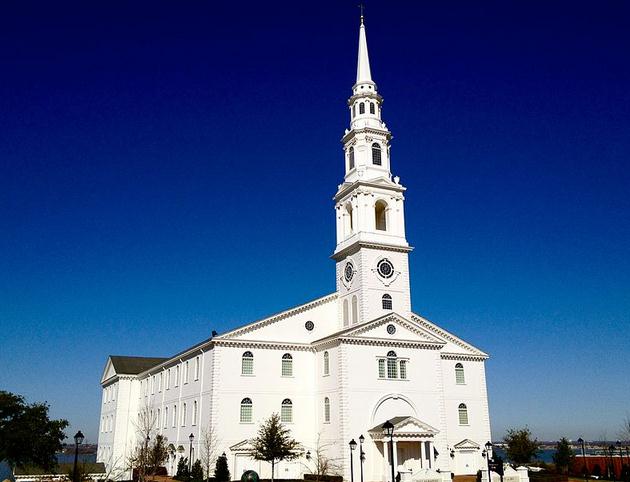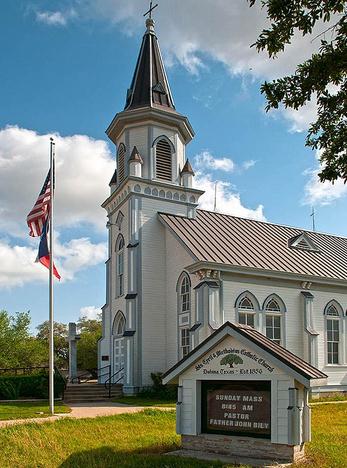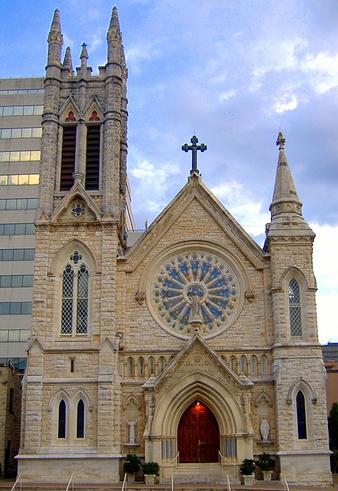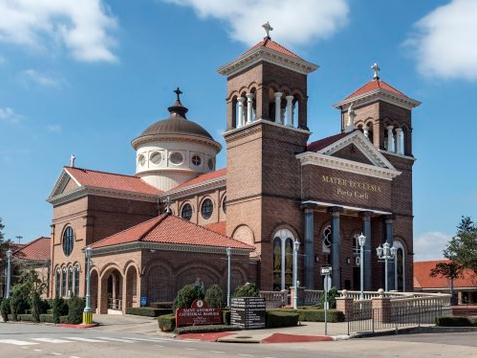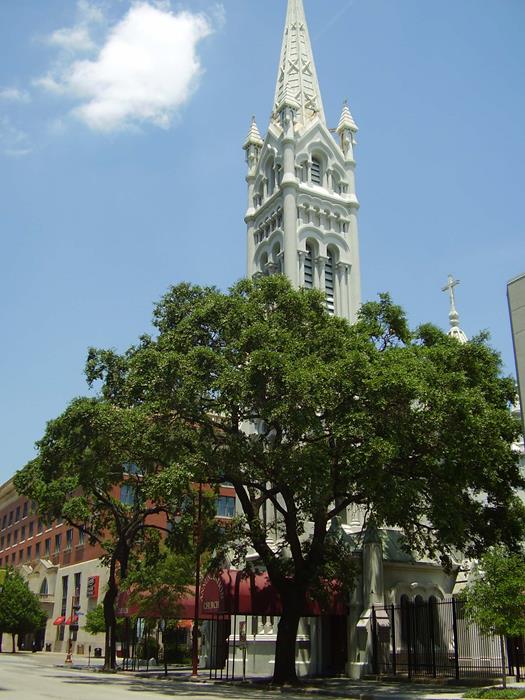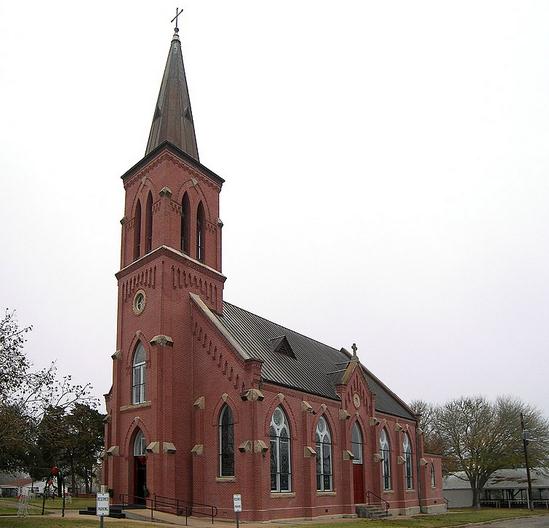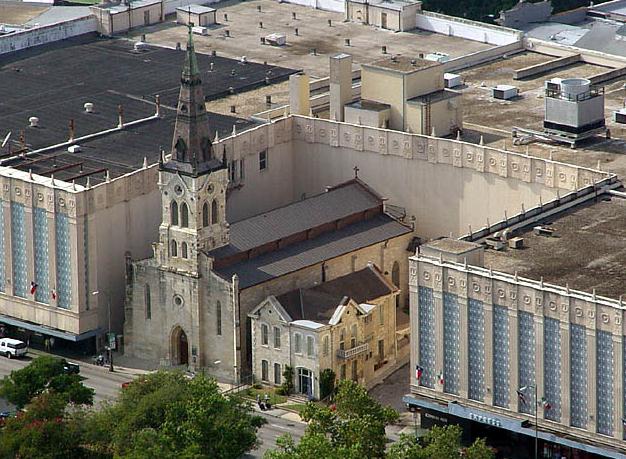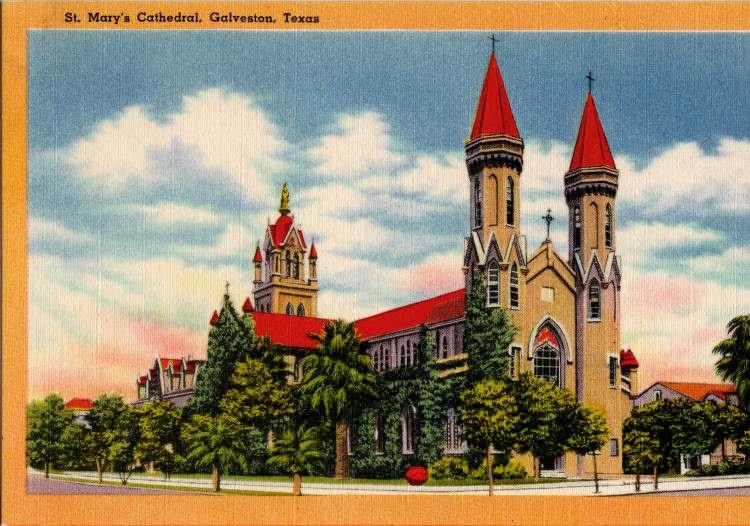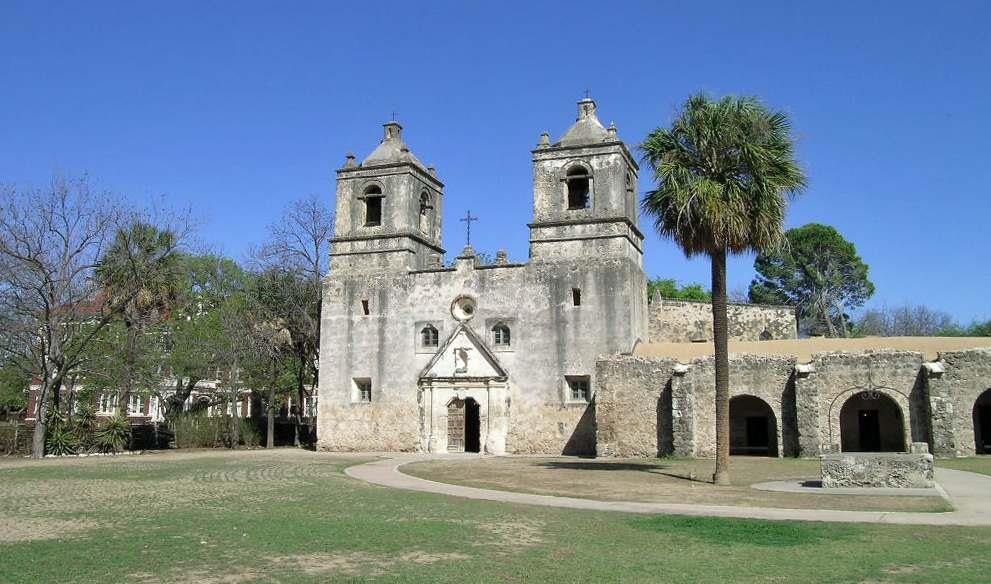Texas has a rich religious history that dates back to when it was a Spanish colony, where Roman Catholicism was the dominant faith. Today, it’s part of the “Bible Belt,” known for its strong Protestant beliefs, especially among conservative communities. But there’s more to the state’s religious scene. Texas is home to a variety of Christian denominations, each with its unique architectural styles, from Colonial and Gothic Revival to Mormon Temple architecture.
Even if you’re not particularly religious, the stunning beauty of these places of worship is undeniable. They range from historic Catholic and Protestant churches to modern temples, all offering a glimpse into Texas’s past and present. You’ll often find these churches near towering skyscrapers, creating a striking contrast between old and new. Exploring these churches can be a highlight of any cultural trip to the Lone Star State.
San Fernando Cathedral (San Antonio)
Founded in 1731 by Canary Island settlers, the San Fernando Cathedral is the oldest continuously functioning religious community in Texas. Its architecture is a seamless blend of Spanish Colonial and French Gothic. San Fernando has been a unifying symbol, serving various denominations during the Spanish and Mexican eras and continuing to be a refuge for the needy.
Its restoration, a careful homage to its historical importance, has been recognized with numerous awards. This breathtaking Catholic church offers Mass in both English and Spanish, carrying the rich history and culture of San Antonio.
First Methodist Church (Houston)
Founded in 1839, the First Methodist Church in Houston is not just a building; it’s a living piece of Texas history. This church, the oldest Methodist congregation in Houston, was initially organized in the Republic’s Capitol Senate Chamber. With its first brick building erected in 1844, the church has witnessed and shaped the city’s history. It has stood resilient through storms like the catastrophic 1900 Galveston hurricane, providing sanctuary and aid to those in need.
Today, this church is more than a spiritual home. Its Aeolian-Skinner organ, a marvel in its own right, and the stunning stained glass windows designed by church member Edward L. Reichert, tell stories of the church’s journey through art and music. The church’s televised services, a testament to its outreach, have the distinction of being the longest-running in the nation.
Saint Mary’s Catholic Church (Fredericksburg)
Located in Fredericksburg, Saint Mary’s Catholic Church was founded in 1846 stands as a beacon of faith and heritage. German and Czech immigrants settled in the historic town of Fredericksburg in the mid-1800s, and by the early 1900s, their descendants had built the first church in the community. This church, deeply rooted in the town’s German origins, is not only a place of worship but also a reflection of the community’s strong cultural and spiritual ties.
The architecture and artistry within its walls speak volumes of the devotion and craftsmanship of its founders and subsequent generations. It will impress you with its stained glass windows, carefully crafted altar, painted walls, elaborate inscriptions, and artwork.
Dallas Baptist University Pilgrim Chapel (Dallas)
The Patty & Bo Pilgrim Chapel at Dallas Baptist University stands as a modern homage to classic colonial church architecture. Officially dedicated in 2009, this 80,000 square-foot facility is a striking addition to the university’s campus, known for its picturesque hilltop setting. The chapel seats over 1,300 individuals, catering to the university’s large student body.
What makes this chapel particularly special is its role as a multifunctional space, housing offices, classrooms, a theater, and a reception hall. The design cleverly integrates state-of-the-art technology and acoustics into a traditional worship space, highlighted by a magnificent pipe organ. This chapel not only serves as a spiritual center but also represents the university’s dedication to combining historical architectural elements with modern functionality, creating a space that resonates with both heritage and contemporary design.
Saints Cyril and Methodius Church (Schulenburg)
Originally established by Czech immigrants, Saints Cyril and Methodius Church in Schulenburg is one of the oldest churches in Texas. This church is part of the Painted Churches of Texas, with interiors featuring exquisite frescoes and stained glass windows.
The original church faced destruction by a hurricane in the late 19th century but was rebuilt. It was again topped by the same iron cross that had been recovered from the debris of the previous church. The church’s revival and continued care reflect the community’s dedication to preserving a vital piece of their cultural and spiritual identity. This enduring landmark not only serves as a place of worship but also as a symbol of the community’s resilience and a bridge connecting past generations with the future
Saint Mary’s Cathedral (Austin)
Saint Mary’s Cathedral in Austin holds a special place in the city’s heart, evolving alongside it since the 1850s. It started as a small stone church, St. Patrick’s, reflecting the Irish Catholic community’s presence in what was then known as Waterloo. The church, originally on the corner of 9th and Brazos Streets, was rechristened as Saint Mary in 1866. As Austin grew, so did the need for a larger, more permanent structure. In 1872, the cornerstone for the new church was laid, marking the beginning of an architectural marvel in High Victorian Gothic style, designed by the talented Nicholas J. Clayton.
The cathedral’s design and structure tell a story of its journey through time. Its interior is adorned with nature-inspired motifs and traditional Gothic elements, a blend that reflects the diversity and vibrancy of Austin itself. The church became the cathedral for the newly formed Diocese of Austin in 1948, a pivotal moment in its history. Over the years, it underwent various modifications, including the 1950s removal of original Gothic decorations, replacing them with contemporary designs that echoed Central Texas, such as cacti and bluebonnets.
Saint Anthony Cathedral Basilica (Beaumont)
Saint Anthony Cathedral, Basilica in Beaumont, stands as a striking example of ecclesiastical architecture and history melding with modernity. It began in 1903 as a parish church and later evolved into a cathedral, reflecting Beaumont’s own development over the years.
This cathedral, much like Saint Mary’s in Austin, adapts and grows to meet the spiritual and communal needs of its congregation. With a rich history that spans decades, Saint Anthony Cathedral Basilica serves not just as a place of worship but also as a symbol of the enduring nature of faith in changing times. It represents the dynamic intersection of tradition and contemporary practice, a characteristic feature of many historic churches in Texas.
Annunciation Catholic Church (Houston)
Annunciation Catholic Church, established in 1869, holds the prestigious title of being the oldest Catholic parish in Houston. Its creation sprung from St. Vincent’s, the city’s first Catholic church. The need for a larger church to accommodate the growing number of Catholics was evident, leading Bishop Claude M. Dubuis and Father Joseph Querat to take the initiative. In a remarkable display of ecumenical spirit, people from various denominations joined hands to raise funds for its construction through community events like festivals and ice cream socials.
Designed by Nicholas J. Clayton in the Gothic revival style, the church mirrors the grandeur of European cathedrals. The church’s tall, slender central tower, completed in 1889, was once Houston’s tallest structure. Clayton’s redesign in the late 19th century added a clerestory level, raised the side walls, and expanded the sanctuary. These modifications included a replica fresco of Raphael’s “The Transfiguration” and a barreled and coffered ceiling in the nave, enhancing the church’s architectural elegance.
Over the years, Annunciation Catholic Church has seen numerous additions and changes, including marble altars, a large rose window, and structural enhancements. This church has been a constant in the lives of Houston’s early leaders and continues to serve its community and visitors.
Nativity of Mary, Blessed Virgin Catholic Church (High Hill)
Nativity of Mary, Blessed Virgin Catholic Church in High Hill, built in 1906, is an architectural and artistic marvel. Designed by Leo M.J. Dielmann, fresh from his studies in Germany, the church showcases classic Gothic revival architecture. It represents the resistance of German and Czech immigrant communities to the more practical “Spanish” or “Mission” style preferred by the Catholic hierarchy for Texas’s climate. The red brick exterior of the church, symbolizing both aesthetic beauty and practical resistance to fire and storms, underscores Dielmann’s mastery of Gothic proportions.
In 1912, the interior was painted by Ferdinand Stockert and Hermann Kern, adding to the church’s splendor. They created the illusion of Gothic groin vaults and joints through their decorative painting, turning the church into a spectacle of visual storytelling. The church’s interior, often mistaken for wallpaper due to the canvas paintings glued to the wooden walls, reflects a blend of spiritual and artistic expressions of the early settlers. This church is also known as the “Queen of the Painted Churches.”
St. Joseph Catholic Church (San Antonio)
In San Antonio, Texas, there’s a unique church, Saint Joseph Catholic Church, which stands almost encircled by a modern shopping mall. Built between 1868 and 1876, this church became the centerpiece of an unusual real estate story. In 1944, when developers planned to build a shopping mall, they approached the church to buy the land. The church’s steadfast community, however, refused to sell. Adapting their plans, the developers constructed the mall around the church instead, leaving it snugly nestled within three sides of modern retail space.
This Gothic Revival church was designed for the German Catholic community by architects G. Friesleben and Theodore Giraud. The church is distinguished by its remarkable limestone structure and a spire added in 1898 by James Wahrenberger, which accentuates its Gothic character. The interior features octagonal wooden columns and a tripartite altar, with ornamental stained-glass windows installed around the turn of the 20th century.
Saint Joseph Catholic Church is a beautiful example of Gothic Revival architecture. Its interior, along with the intricate stained-glass windows, is a sight to behold, making it a must-visit spot for both architecture enthusiasts and visitors interested in unique urban church settings.
St. Mary’s Cathedral Basilica (Galveston)
St. Mary’s Cathedral Basilica in Galveston is not just a church but a cornerstone of Texas Catholic history. Established in 1847 as the cathedral for the Diocese of Galveston, which then encompassed the entire state, St. Mary’s has witnessed significant historical events.
Designed by Theodore E. Giraud, the cathedral is a beautiful example of Gothic Revival architecture. The structure, inspired by King’s College Chapel in Cambridge, England, includes a 130 feet long and 75 feet wide nave and transepts extending 100 feet wide by 60 feet high. Notably, Nicholas J. Clayton, a prominent architect, added a transept tower and heightened the twin spires in the late 19th century.
The cathedral also played an important role during the 1900 Galveston hurricane, enduring as a symbol of resilience. In 1979, it was elevated to the status of a minor basilica by Pope John Paul II, further recognizing its historical and spiritual importance.
Mission Concepción (San Antonio)
Mission Concepción in San Antonio, part of the San Antonio Missions National Historical Park, is a witness to Texas’ rich colonial history. Established in the 18th century, it’s one of the oldest original stone churches in America. The mission has remained nearly unchanged since its construction, retaining much of its original design and frescoes.
Mission Concepción stands as a symbol of the blending of Spanish and Coahuiltecan cultures. The church’s architecture, notable for its dome and beautiful stone walls, has withstood the test of time. It played a significant role in community life for both the Spanish settlers and indigenous people. Today, it’s not only an active parish but also a cherished historical site, attracting visitors who come to admire its well-preserved architecture and learn about the early days of Texas under Spanish rule.
Conclusion
These churches are not just places of worship; they are living monuments to Texas’s rich and varied history, inviting us to reflect on the past while inspiring faith and community in the present. As we conclude this journey, we’re reminded of the enduring power of faith and architecture in shaping the cultural and spiritual landscape of a region.

